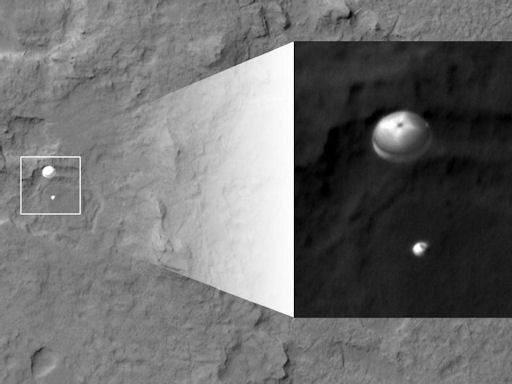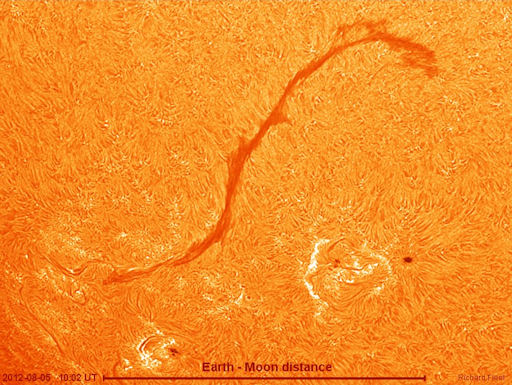Listen to radar echoes from satellites and meteors, live on listener-supported Space Weather Radio. | | |
CHANCE OF STORMS: NOAA forecasters estimate a 25% chance of polar geomagnetic storms on August 7/8. That's when a coronal mass ejection (CME) hurled into space by a filament eruption on Aug. 4 could deliver a glancing blow to Earth's magnetic field. Aurora alerts: text, voice.
NEW IMAGES FROM MARS: NASA has just released a spectacular new image of Curiosity descending to Mars. Taken by the HiRISE camera onboard the Mars Reconnaissance Orbiter, the snapshot shows the parachute fully inflated about one minute before touchdown:

NASA commentary: "The parachute appears fully inflated and performing perfectly. Details in the parachute, such as the band gap at the edges and the central hole, are clearly seen. The cords connecting the parachute to the back shell cannot be seen, although they were seen in the image of NASA's Phoenix lander descending, perhaps due to the difference in lighting angles. The bright spot on the back shell containing Curiosity might be a specular reflection off of a shiny area. Curiosity was released from the back shell sometime after this image was acquired."
Stay tuned for more images.
CURIOSITY LANDS ON MARS: NASA's "seven minutes of terror" ended with cries of joy from mission control at the Jet Propulsion Lab on August 6th when Curiosity sucessfully landed on Mars. One of the first pictures the rover sent back was of its own shadow:

This picture was taken through a wide-angle lens on rover's rear Hazard-Avoidance camera. It's only one-quarter of full resolution.As planned, the rover's early engineering images are lower resolution. Larger color images are expected later in the week when the rover's mast, carrying high-resolution cameras, is deployed.
Curiosity landed at 10:32 p.m. PDT Aug. 5, (1:32 a.m. EDT Aug. 6) inside Gale Crater near the foot of a layered mountain three miles tall and 96 miles in diameter. Observations from orbit have identified clay and sulfate minerals in the mountain's lower layers, indicating a wet history. For the next two years (at least) the rover will search the layers for ancient habitats that might have supported Martian microbial life.
Curiosity carries 10 science instruments. Some are the first of their kind on Mars, such as a laser-firing instrument for checking the chemical make-up of rocks from a distance. The rover will use a drill and scoop at the end of its robotic arm to gather soil and powdered samples of rock interiors, then sieve and parcel out these samples into analytical laboratory instruments inside the rover. To handle this science toolkit, Curiosity is twice as long and five times as heavy as Spirit or Opportunity.
SUN SERPENT: Amateur astronomers arpund the world are monitoring a gigantic filament of magnetism on the sun. If one end of the filament were on Earth, the other end would reach all the way to the Moon. The dimensions of the structure make it an easy target for amateur solar telescopes. Richard Fleet sends this picture from his backyard observatory in Wiltshire, England:

This filament is filled with billions of tons of plasma, yet it has remained suspended above the surface of the sun for days. Such a massive structure, buffeted as it is by winds and currents in the sun's atmosphere, is unlikely to remain stable much longer. If the filament collapses, it could crash into the surface of the sun and spark a powerful type of explosion called a Hyder flare. Amateur astronomers are encouraged to monitor developments.
Realtime Space Weather Photo Gallery
Realtime Meteor Photo Gallery
Realtime Noctilucent Cloud Photo Gallery
[previous years: 2003, 2004, 2005, 2006, 2007, 2008, 2009, 2011]

